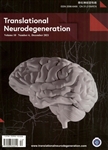Longitudinal evolution of cortical thickness signature reflecting Lewy body dementia in isolated REM sleep behavior disorder:a prospective cohort study
作者机构:Department of NeurologySeoul Metropolitan Government-Seoul National University Boramae Medical Center and Seoul National University College of MedicineSeoulSouth Korea Department of Nuclear MedicineSeoul Metropolitan Government-Seoul National University Boramae Medical Center and Seoul National University College of MedicineSeoulSouth Korea Institute of Radiation MedicineMedical Research CenterSeoul National UniversitySeoulSouth Korea Department of NeurologySeoul National University Hospital and Seoul National University College of MedicineSeoulSouth Korea
出 版 物:《Translational Neurodegeneration》 (转化神经变性病(英文))
年 卷 期:2023年第12卷第1期
页 面:514-528页
核心收录:
学科分类:1002[医学-临床医学] 1001[医学-基础医学(可授医学、理学学位)] 100214[医学-肿瘤学] 10[医学]
基 金:supported by a research grant of National Research Foundation(NRF)funded by the Ministry of Education,Science and Technology(MEST)in Korea(NRF-2018R1C1B3008971,2018R2A5A2025974,2021R1C1C1011077,NRF-2020R1I1A1A01054095) the Korea government(MSIT)Ministry of Science and ICT(NRF-2022R1A2C4001834)
主 题:Rapid eye movement sleep behavior disorder Dementia with Lewy bodies Lewy body disease Cortical thickness Spatial covariance pattern Magnetic resonance imaging
摘 要:Background The isolated rapid-eye-movement sleep behavior disorder(iRBD)is a prodromal condition of Lewy body disease including Parkinson’s disease and dementia with Lewy bodies(DLB).We aim to investigate the longitudinal evolution of DLB-related cortical thickness signature in a prospective iRBD cohort and evaluate the possible predictive value of the cortical signature index in predicting dementia-first phenoconversion in individuals with *** We enrolled 22 DLB patients,44 healthy controls,and 50 video polysomnography-proven iRBD *** underwent 3-T magnetic resonance imaging(MRI)and clinical/neuropsychological *** characterized DLB-related whole-brain cortical thickness spatial covariance pattern(DLB-pattern)using scaled subprofile model of principal components analysis that best differentiated DLB patients from age-matched *** analyzed clinical and neuropsychological correlates of the DLB-pattern expression scores and the mean values of the whole-brain cortical thickness in DLB and iRBD *** repeated MRI data during the follow-up in our prospective iRBD cohort,we investigated the longitudinal evolution of the cortical thickness signature toward Lewy body ***,we analyzed the potential predictive value of cortical thickness signature as a biomarker of phenoconversion in iRBD *** The DLB-pattern was characterized by thinning of the temporal,orbitofrontal,and insular cortices and relative preservation of the precentral and inferior parietal *** DLB-pattern expression scores correlated with attentional and frontal executive dysfunction(Trail Making Test-A and B:R=−0.55,P=0.024 and R=−0.56,P=0.036,respectively)as well as visuospatial impairment(Rey-figure copy test:R=−0.54,P=0.0047).The longitudinal trajectory of DLB-pattern revealed an increasing pattern above the cut-off in the dementia-first phenoconverters(Pearson’s correlation,R=0.74,P=6.8×10−4)but no significant change in parki



